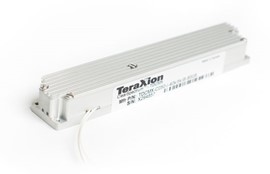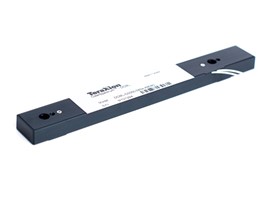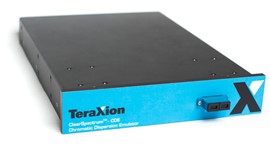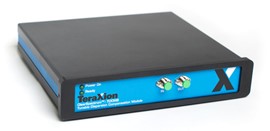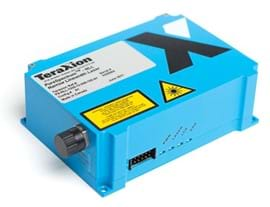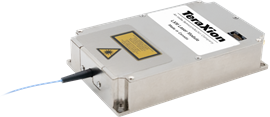Optical Communication and RF Components
Built on more than 20 years of product innovation, TeraXion has developed an unmatched expertise in FBG technology used to deliver reliable chromatic dispersion management modules and narrow bandwidth optical filters for the dense wavelength-division multiplexing (DWDM) optical communications industry. Moreover, TeraXion provides very narrow-linewidth DFB lasers to support analog and digital transmission in optical fiber links.
The move towards a hyper-connected world is forcing the optical communications landscape to evolve at an astounding speed. Many new services, such as enhanced broadband experience, cloud-computing and secure quantum communications are driving this change. As the transition to this hyper-connected world is accelerating, end-user expectations are also growing, leading to the generation of an ever-increasing quantity of data that must be transmitted.
The bandwidth demand created by this massive circulation of information stresses networks, particularly access networks, from data center interconnect to access networks. This leads operators to increase their networks’ capacity while keeping the cost-per-bit at a minimum. A reliable and effective way to achieve this is to use DWDM, intensity modulation direct-detection (IMDD) solutions.
TeraXion provides a range of chromatic dispersion management and emulation products that address the current expansion needs and enable researchers to develop next-generation solutions at a reasonable cost.
Applications
Products
DCI & access DWDM systems
East-to-west traffic among regional and distributed data centers is increasing rapidly. To meet this demand, interconnect data rates must increase from 10 Gbps to 100 Gbps. Direct-detection solutions, such as 100G DWDM PAM4, addresses the major cost-per-bit concerns of operators; however, chromatic dispersion is becoming a growing challenge as data rates and distances continue to rise. The TDCMX-SM efficiently manages chromatic dispersion in point-to-point links, enabling direct-detection transmissions of up to 80 km using a single, simple module.
The continuous increase in data rates is also reflected in access and enterprise networks. Once the mainstream in long-haul networks, DWDM architectures at 10 Gb/s and 25 Gb/s are getting closer now to end users through access networks. In many cases, the reach of these systems is limited by optical fiber chromatic dispersion. To overcome this limitation, TeraXion has delivered several tens of thousands of its flagship DCML solutions, which are compact and low-latency dispersion compensation modules that significantly extend the reach of any DWDM signal at 10, 25 and 100 Gb/s.
Coherent transceiver testing
An ever-increasing need for bandwidth is driving the development and deployment of new technologies, ranging from 200 Gb/s to 800 Gb/s, in the optical communications field. A critical aspect of this research is the assessment and mitigation of chromatic dispersion effects.
TeraXion’s line of chromatic dispersion emulation products use exclusive fiber Bragg grating (FBG) technology to replace kilometers of optical fiber with compact benchtop instruments, making these emulators ideal for both laboratories and production floors.
Radio frequency over fiber
High-end applications that require the transmission of RF signals using photonics benefit from the low loss and lightness of optical fiber combined with the high-speed response of optoelectronic components. In these applications, an optical carrier is used to transport RF information over an optical fiber, and the RF signal may consist of one or more RF subcarriers modulated by analog signals.
TeraXion’s PureSpectrum™ lasers provide a low-noise, stable optical carrier for RF photonic links, whereas TeraXion’s suite of high-isolation, narrowband FBG filters allows efficient side-band suppression and signal isolation for a much improved spur-free dynamic range (SFDR) for the link.
Quantum Communications
Quantum technologies are a major focus globally and lead to exciting and significant technological advances. Optical components must therefore adapt to the requirements and constraints imposed in terms of performance, parametrization and quality, for either testing new quantum key distribution (QKD) protocols or to develop the latest generation of commercial systems.
TeraXion’s optical filters are used to control several key characteristics of the signal with high precision, thus ensuring optimization and consistency at different stages in the system while increasing resilience to a new breed of cyberattacks.
TeraXion’s chromatic dispersion compensators allow for longer transmission links while minimizing signal degradation that is more than ever a critical notion considering the physics of quantum distribution.
Fiber Sensing
Fiber sensing enables the interrogation of an optical fiber deployed in sites, such as infrastructures, optical communications networks, power plants, oil fields, etc. Variations in temperature, strain, or vibration induce changes in the scattering properties of optical fiber: these changes are detected by the fiber sensing system and provide information about the environment surrounding the fiber. Events, such as intrusion or safety hazards, can therefore be detected and monitored when they occur—from the exact location where they take place.
TeraXion’s PureSpectrum™ narrow linewidth DFB laser modules, with their intrinsic stability and long coherence length, enable the precise detection and measurement of events that occur far away from the interrogator. TeraXion’s high-performance fiber Bragg grating optical filters can isolate a signal or a group of signals for optimized detection. They can also eliminate undesired signals, such as amplified spontaneous emission (ASE) or stimulated Brillouin scattering (SBS), leading to more sensitive and accurate measurements.


